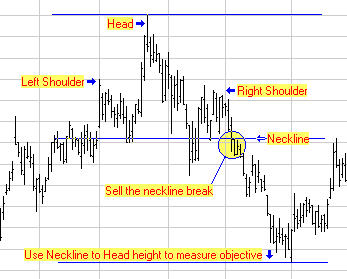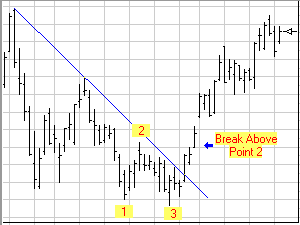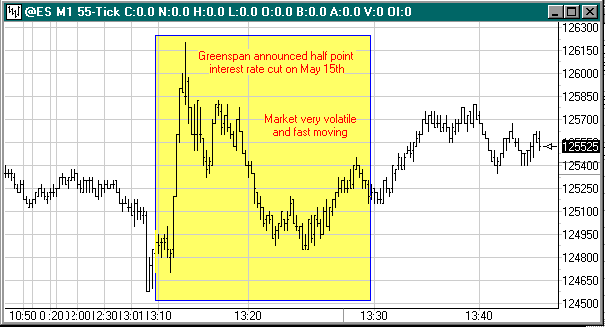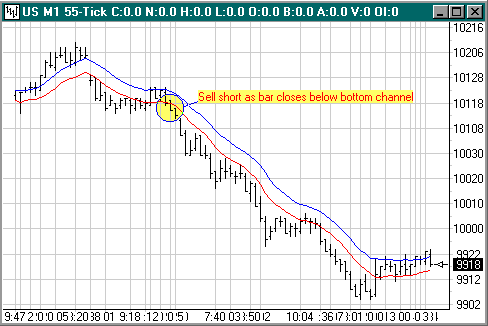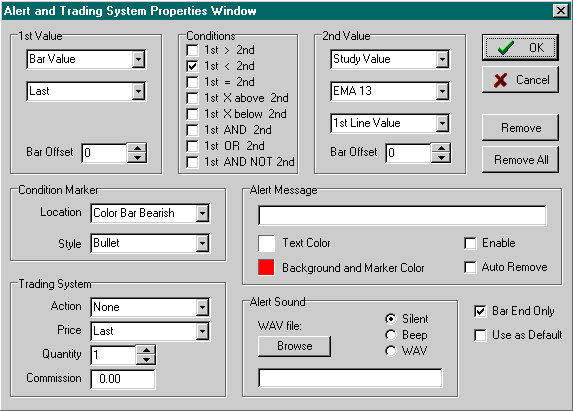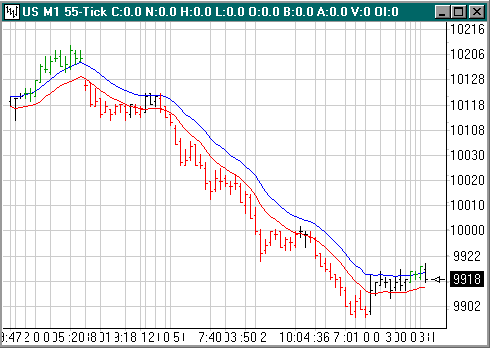ES: What is your experience in trading? DH: I started trading stocks out of college in the early 1970s, and have traded about everything through the years. I have given more emphasis to position trading in grains, softs, currencies, and have done some trading in e-mini and bonds lately. ES: What computer equipment do you use? DH: I use two computers, one of which is a notebook. Both computers have dual displays. The desktop is 500 MHz, 128 Meg, with 2 monitors running Ensign Windows. My data feed is from DTN by satellite to their D7000 Spectrum receiver box, with delayed stock quotes and real-time data for all futures exchanges. ES: Tell about your brokerage business? DH: I have been a broker since 1986, and started with Dean Whitter. I have been independent since 1990. I have clients in 7 or 8 states and a few active clients overseas (Brazil). Being located in North Dakota, a lot of my clients trade grain and livestock futures. Commissions will vary $25 to $40 for full service. Full service includes a lot of hand holding, advice, training and explaining technical analysis. Some clients also want recommendations. Many of my customers have traded with me for 10 to 15 years. ES: Are there favorite studies and tools you rely on? DH: Yes, there are. I recommend that my clients read 2 or 3 books. I want them to read the books by Bill Williams called 'Trading Chaos' and 'New Trading Dimensions'. I also like Joe DiNapoli's 'Trading with DiNapoli Levels'. (www.fibtrader.com) These books are listed in their order of ascending complexity and involvement. Also, I recommend 'The Disciplined Trader' by Mark Douglas. My favorite studies are moving averages, and the old standby Relative Strength Index (RSI). I use the moving averages the way Bill Williams uses them, with a slight twist which includes the Moving Average Convergence/Divergence study (MACD). Most of the time I have RSI on the chart. The discipline to use stops with money management is the key to trading. I donít want to make it sound like I have all the answers. I am always working to improve my consistency. I admit at times I am streaky being hot when I am hot and cold when Iím not. ES: Are there favorite chart formations you look for? DH: There are two formations I look for: Head and Shoulders, and the 1-2-3 pattern at bottoms and tops. A 1-2-3 pattern at a bottom can be described as having point 1 at a bottom, bounce up to 2 and back down to 3 but not violate point 1. My buy point would be going upward through point 2. I also like channel break outs. Basically I am a break out trader. On the head and shoulders pattern, I trade a break of the neckline and also use the pattern to measure a price objective from the neck line to the top of the head flipped over.
ES: Do you use any research? DH: I have a squawk box from the head office and receive research news from Ag Resource. I consider myself to be 20 percent fundamental and 80 percent technical. ES: What pit falls have you learned to avoid? DH: Through the years I see traders try to ride through adversity thinking it cannot go lower. Yet it does. The lesson seems to be learned again and again in thinking a bargain cannot go lower. We get it in our heads where we fight the markets and resist what we see. The correct philosophy is 'See it, Believe it, and Trade it'. It is a fallacy to impose your own ideas on the markets. Another rule I use is I donít add to a loser. I admit I have done so, but it is very dangerous trying to average out a loser. Traders usually get forced out of wrong positions by margin calls. ES: What time-frames do you use for your charting? DH: I mainly use constant tick charts, and Fibonacci numbers for everything. For example, I use 34 and 55 tick charts for the e-mini which often translates to a 3-minute bar. With grains I use a 13 or 21 tick chart which is often around a 7-minute chart. For a longer time frame I look at a 30-minute chart and then convert that back to a constant tick chart to the nearest Fibonacci number. You can obtain the tick count to use by examining the volumes on the 30-min chart at about 5 different points during an average day. If the 30-minute volume samples average to be 150 ticks, I would use a 144 constant tick chart as my longer time frame reference chart. First thing each morning I go through my daily and weekly charts to get a feel for the bigger picture. I like to trade in the direction of the larger time frame like the 144 or 233 tick chart. I trade a shorter time period chart, but only in the direction of the next larger time frame chart. (ES tip: The Fibonacci number sequence is 1 - 2 - 3 - 5 - 8 - 13 - 21 - 34 - 55 - 89 - 144 - 233 etc.) ES: How frequently do you trade? DH: When day trading the e-mini it might get hectic, and I'm trying to reduce my trades. But I still find I trade 10 to 20 times a day on the 55 tick chart. My primary tools are the moving averages, MACD and RSI. I create a channel using a moving average through the highs, and a moving average through the lows. I use averages, similar to the Alligator described in Williams' book. I use longer average parameters such as 21 and 55 for the high and low channels because volatility has increased in these markets. I also keep a 200 period average on all time frames to center my mind on the direction of the market. (ES: See an example of Don's moving average channel in the next article.) ES: What constitutes a successful trade for you? DH: In e-mini, I try to stay with it and use a trailing stop. One rule I use is after 10 points of profit I accept partial profits. Same principle is used with grains. I first try to bank some profit, and 2nd, I try to give the market an opportunity to run by giving it some room to breathe. ES: What kind of market conditions do you look for? DH: I love trending markets, but markets trend only 30% of the time and are choppy 70% of the time. I would love to be in only trending markets, but it is hard to know or figure out when trends will happen. I like to use some Elliott wave counts to find the Elliott 1-2-3-4-5 pattern and be aboard for the 3rd wave moves. I generally avoid bottom and top picking. I love to be on board for the 3rd wave. Though it is sometimes hard to find, it is what I am looking for. I don't like to be in the markets when Mr. Greenspan speaks. I prefer to be on the sidelines when markets have huge volatility.
ES: Do you use any risk management or money management techniques? DH: I need to emphasize using stops to your readers. If you cannot see a comfortable level for the stop considering your ability to afford the risk, then pass on the trade. Do not risk more than 2 to 3 percent of your account on any one trade. ES: What advice would you offer to new traders? DH: My advice is to go very, very slow and get a bit of diversity. Pay attention to margin costs. If there is a high margin that means there is high risk. Go with low margin, low risk issues that have high liquidity. Paper trade and master it before actually trading. If you feel you must have money in the market while you learn, begin by trading Oats. ES: Any comments on brokers or order execution? DH: The majority of institutions and brokerages are very consistent. Anyone can have problems on any given day. We have active markets using electronics, and crap can happen when we do not want it. But it is just part of the nature of the business because it is getting so high tech. Thinking that a split second faster is better is just fooling yourself. On the whole if I wait a second or two longer I get a better trade. So in the long run, it does not make any difference to try to be a few seconds faster. ES: Do you use a mechanical trading system? DH: No, I have never used a mechanical system. I do use technical analysis tools, but still want to add my own feel and subjectivity. All mechanical systems seem to work part-time and I've never been inclined to throw money into any of the mechanical black box systems that are often advertised. As close as I come to a system is the service from Nick Van Nice, president of Commodity Trend Service out of North Palm Beach, FL. His service is called Trendsetter which is a longer term mechanical system I have followed for 10 years. He is open in disclosing the rules of the system. I donít necessarily follow his rules, yet I also donít fight against his system. I have read over 30 books on trading, but have not yet attended any trading seminars.
Trading Tip:
This is the constant 55 tick chart that Don Henry was watching the morning of May 10th when June bonds started to break below the lower red channel line. This break is highlighted in yellow. Don was in the Ensign Chat Room at the time and pointed the break out to others in the chat room (I was there too). Don explained how he was looking at a 55 tick chart for bonds, with a 13 period exponential average of the Highs, and a 13 period exponential average of the Lows. Don said this was a break formation he liked to short and would ride it down until it closed above the upper channel line, which occurred 1-26/32nds points lower and 4 days later on May 14th. A 13 period exponential average of the Highs is configured on the study properties window as shown. Note that the Data Point used by the study is the High. Add a 2nd exponential average to the chart and configure it to use the Low Data Point. The easiest way to display a constant tick chart is to first set up a button for it on the Times panel.Trading Tip: Continuing with Don's moving average channel break out,
an Alert can be set to indicate when the bar's close has
broken above or below the channel lines. Select the Alert
Object
The 1st Value is selecting the Last Bar Value, and comparing it to the 1st Line Value of the 13-period Exponential Moving Average Study that is on the chart. The chart has two moving averages and this example is using the 2nd average which created the lower channel band by averaging the Lows. The Condition Marker will Color the Bar Bearish using a Red color when the Last is less than the Study Value. A 2nd Alert Object is added to the chart, and its properties are similar to those shown. The difference is that the Condition checked is 1st > 2nd . The Study Value needs to use the 13-period EMA which averages the Highs. Set the Condition Marker to Color the Bar Bullish. These two alert objects will color the bars on the chart as shown.
When the bar's close is below the lower channel line, the bar is colored Red. When the bar's close is above the upper channel line, the bar is colored Green. Otherwise, the close is between the channel bands and remains its normal color. If you want an Alert Message to pop up on the chart when the bar closes above or below a channel line, then modify the properties for the 2 alert objects added to this chart. Enter a message to display and check the Enable box on the properties form for each Alert Object |
